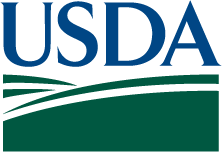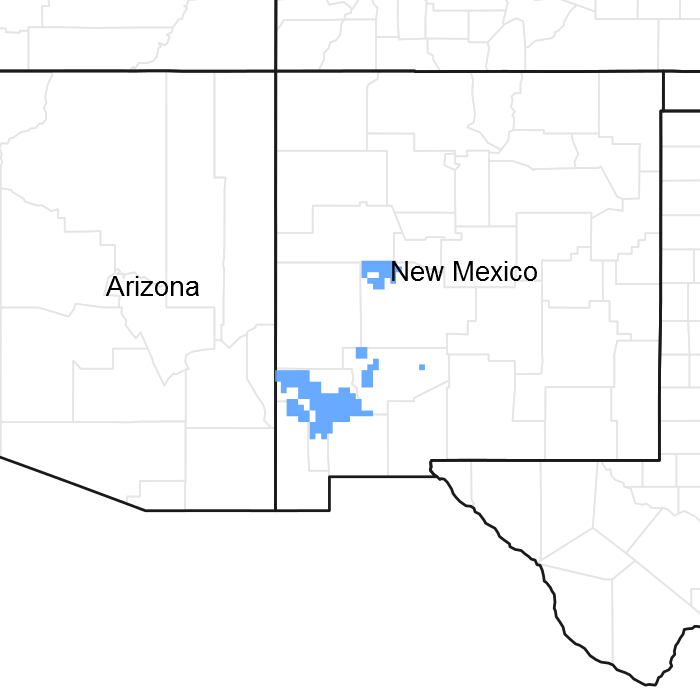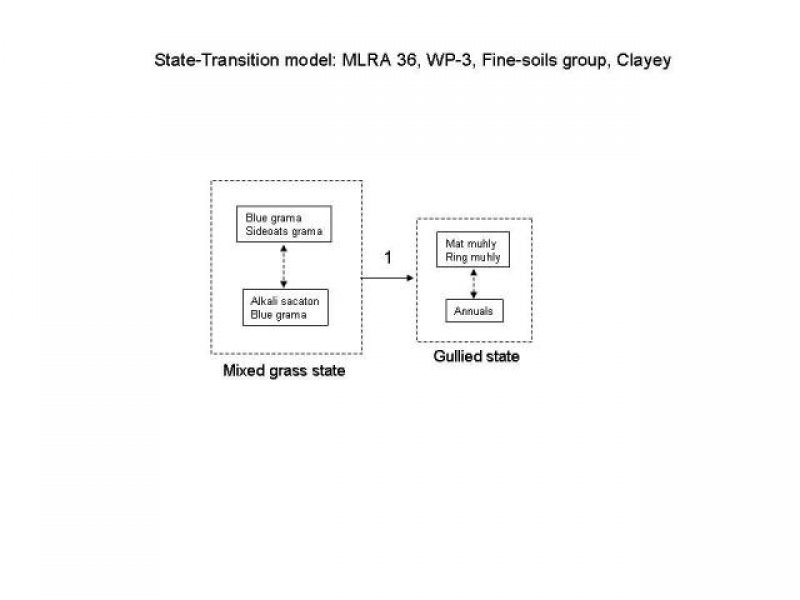
Natural Resources
Conservation Service
Ecological site R038XB107NM
Clayey
Accessed: 12/18/2025
General information
Provisional. A provisional ecological site description has undergone quality control and quality assurance review. It contains a working state and transition model and enough information to identify the ecological site.

Figure 1. Mapped extent
Areas shown in blue indicate the maximum mapped extent of this ecological site. Other ecological sites likely occur within the highlighted areas. It is also possible for this ecological site to occur outside of highlighted areas if detailed soil survey has not been completed or recently updated.
Table 1. Dominant plant species
| Tree |
Not specified |
|---|---|
| Shrub |
Not specified |
| Herbaceous |
Not specified |
Physiographic features
The topography of this site is level to moderately sloping and may include slightly depressed or swale-type positions which receive runoff from adjacent sites. Slopes range from 0 to 10 percent, but average less than 5 percent. Elevations range from just under 5,000 feet to just over 6,800 feet above sea level.
Table 2. Representative physiographic features
| Landforms |
(1)
Depression
(2) Swale |
|---|---|
| Flooding duration | Very brief (4 to 48 hours) |
| Flooding frequency | Rare to frequent |
| Elevation | 5,000 – 6,800 ft |
| Slope | 10% |
| Aspect | Aspect is not a significant factor |
Climatic features
Average annual precipitation varies from about 12 inches to just over 16 inches. Substantial fluctuations from year to year are common, ranging from a low of about 6 inches to a high of over 30 inches. Approximately one-half of the annual precipitation comes in the form of rainfall during the months of July, August, and September, although wintertime precipitation in the form of snow, sleet, or rain is sometimes significant. Spring and late fall months are normally dry.
The average frost-free period ranges from about 165 to 190 days and extends from approximately the third or fourth week in April to mid October. Average annual air temperatures are about 56 degrees F. Summer maximums can exceed 100 degrees F and winter minimums on occasion go below zero. Monthly mean temperatures generally exceed 70 degrees F for the period of June through August.
Growing conditions favor warm-season perennial vegetation, although late winter and late summer precipitation is adequate to foster a significant cool-season component in the potential plant community. Occasional wet springs also create good conditions for annual forb production, but frequent winds from the west and southwest are common during this time of year and tend to deplete soil moisture at a critical time for the growth of these plants.
Climate data was obtained from http://www.wrcc.sage.dri.edu/summary/climsmnm.html web site using 50% probability for freeze-free and frost-free seasons using 28.5 degrees F and 32.5 degrees F respectively.
Table 3. Representative climatic features
| Frost-free period (average) | 187 days |
|---|---|
| Freeze-free period (average) | 211 days |
| Precipitation total (average) | 16 in |
Figure 2. Monthly precipitation range
Figure 3. Monthly average minimum and maximum temperature
Influencing water features
This site is not influenced by water from a wetland or stream.
Soil features
Typical soils are moderately deep to deep well drained. The surface layer is fine or moderately fine. Sometimes it has a very thin layer that is medium textured and are slowly permeable. Water intake rates are moderate to slow. Soil cracking following dry periods provides opportunity for occasional deep wetting upon finally receiving moisture. Runoff in the absence of good vegetative cover can be high, and water-holding capacity is moderate to high.
Table 4. Representative soil features
| Surface texture |
(1) Gravelly clay loam (2) Loam |
|---|---|
| Family particle size |
(1) Clayey |
| Drainage class | Well drained |
| Permeability class | Slow |
| Soil depth | 20 – 72 in |
| Surface fragment cover <=3" | 15 – 35% |
| Available water capacity (0-40in) |
3 – 12 in |
| Electrical conductivity (0-40in) |
16 mmhos/cm |
| Soil reaction (1:1 water) (0-40in) |
6.6 – 9 |
| Subsurface fragment volume <=3" (Depth not specified) |
57% |
Ecological dynamics
Retrogression in the plant community is characterized by increases in such plants as tobosa, threeawns, burrograss, and mesquite. Broom snakeweed and an abundance of annuals may also be symptomatic of site deterioration, especially if there are numerous areas of bare ground and an obvious absence or near absence of the better climax species such as the gramas. Following severe deterioration, the site does not recover rapidly through improved grazing management alone.
State and transition model

More interactive model formats are also available.
View Interactive Models
More interactive model formats are also available.
View Interactive Models
Click on state and transition labels to scroll to the respective text
Ecosystem states
State 1 submodel, plant communities
State 1
Historic Climax Plant Community
Community 1.1
Historic Climax Plant Community
This is a grassland site characterized by short and mid-grasses. Blue grama and sideoats grama are the dominant grasses. Such species as black grama, alkali sacaton, tobosa, and bottlebrush squirreltail are also characteristic although alkali sacaton may not be present in all cases. Fourwing saltbush, winterfat, and yucca are common woody species, with broom snakeweed coming and going cyclically and as condition deteriorates. Forbs such as perennial buckwheat and globemallow also occur commonly on the site but not often in substantial amounts. NOTE: Where site occurs in depressed areas or shallow swale positions, additional overflow may cause the site to support as much as 15 percent western wheatgrass, 20 percent tobosa or galleta, and 10 percent vine-mesquite. Under these conditions, blue grama normally will not exceed 20 percent.
Figure 4. Annual production by plant type (representative values) or group (midpoint values)
Table 5. Annual production by plant type
| Plant type | Low (lb/acre) |
Representative value (lb/acre) |
High (lb/acre) |
|---|---|---|---|
| Grass/Grasslike | 255 | 500 | 744 |
| Forb | 24 | 47 | 70 |
| Total | 279 | 547 | 814 |
Table 6. Ground cover
| Tree foliar cover | 0% |
|---|---|
| Shrub/vine/liana foliar cover | 4% |
| Grass/grasslike foliar cover | 0% |
| Forb foliar cover | 0% |
| Non-vascular plants | 0% |
| Biological crusts | 0% |
| Litter | 12% |
| Surface fragments >0.25" and <=3" | 0% |
| Surface fragments >3" | 0% |
| Bedrock | 0% |
| Water | 0% |
| Bare ground | 62% |
Figure 5. Plant community growth curve (percent production by month). NM0607, R038XB107NM Clayey HCPC. R038XB107NM Clayey HCPC Mixed short/mid-grassland with shrub and forb component..
| Jan | Feb | Mar | Apr | May | Jun | Jul | Aug | Sep | Oct | Nov | Dec |
|---|---|---|---|---|---|---|---|---|---|---|---|
| J | F | M | A | M | J | J | A | S | O | N | D |
| 0 | 0 | 5 | 7 | 10 | 15 | 25 | 25 | 8 | 5 | 0 | 0 |
Additional community tables
Table 7. Community 1.1 plant community composition
| Group | Common name | Symbol | Scientific name | Annual production (lb/acre) | Foliar cover (%) | |
|---|---|---|---|---|---|---|
|
Grass/Grasslike
|
||||||
| 1 | 176–235 | |||||
| blue grama | BOGR2 | Bouteloua gracilis | 176–235 | – | ||
| 2 | 59–88 | |||||
| sideoats grama | BOCU | Bouteloua curtipendula | 59–88 | – | ||
| 3 | 88–118 | |||||
| James' galleta | PLJA | Pleuraphis jamesii | 88–118 | – | ||
| tobosagrass | PLMU3 | Pleuraphis mutica | 88–118 | – | ||
| alkali sacaton | SPAI | Sporobolus airoides | 88–118 | – | ||
| 4 | 6–29 | |||||
| black grama | BOER4 | Bouteloua eriopoda | 6–29 | – | ||
| 5 | 6–29 | |||||
| vine mesquite | PAOB | Panicum obtusum | 6–29 | – | ||
| 6 | 18–29 | |||||
| squirreltail | ELEL5 | Elymus elymoides | 18–29 | – | ||
| 7 | 6–29 | |||||
| cane bluestem | BOBA3 | Bothriochloa barbinodis | 6–29 | – | ||
| Arizona cottontop | DICA8 | Digitaria californica | 6–29 | – | ||
| plains lovegrass | ERIN | Eragrostis intermedia | 6–29 | – | ||
| plains bristlegrass | SEVU2 | Setaria vulpiseta | 6–29 | – | ||
| 8 | 6–18 | |||||
| low woollygrass | DAPU7 | Dasyochloa pulchella | 6–18 | – | ||
| curly-mesquite | HIBE | Hilaria belangeri | 6–18 | – | ||
| creeping muhly | MURE | Muhlenbergia repens | 6–18 | – | ||
| mat muhly | MURI | Muhlenbergia richardsonis | 6–18 | – | ||
| 9 | 18–47 | |||||
| threeawn | ARIST | Aristida | 18–47 | – | ||
| burrograss | SCBR2 | Scleropogon brevifolius | 18–47 | – | ||
| 10 | 6–18 | |||||
| Graminoid (grass or grass-like) | 2GRAM | Graminoid (grass or grass-like) | 6–18 | – | ||
|
Forb
|
||||||
| 11 | 6–18 | |||||
| croton | CROTO | Croton | 6–18 | – | ||
| buckwheat | ERIOG | Eriogonum | 6–18 | – | ||
| globemallow | SPHAE | Sphaeralcea | 6–18 | – | ||
| 12 | 6–18 | |||||
| Forb, annual | 2FA | Forb, annual | 6–18 | – | ||
| 13 | 6–29 | |||||
| Forb, perennial | 2FP | Forb, perennial | 6–29 | – | ||
|
Shrub/Vine
|
||||||
| 14 | 6–18 | |||||
| fourwing saltbush | ATCA2 | Atriplex canescens | 6–18 | – | ||
| 15 | 6–18 | |||||
| longleaf jointfir | EPTR | Ephedra trifurca | 6–18 | – | ||
| pale desert-thorn | LYPA | Lycium pallidum | 6–18 | – | ||
| yucca | YUCCA | Yucca | 6–18 | – | ||
| 16 | 6–18 | |||||
| winterfat | KRLA2 | Krascheninnikovia lanata | 6–18 | – | ||
| 17 | 6–18 | |||||
| broom snakeweed | GUSA2 | Gutierrezia sarothrae | 6–18 | – | ||
Interpretations
Animal community
This ecological site provides habitat which can support a resident animal community characterized by desert cottontail, Botta’s pocket gopher, bannertail kangaroo rat, southern plains woodrat, coyote, burrowing owl, meadowlark, scaled quail, lesser earless lizard, leopard lizard, and short-horned lizard.
Where shrubs are present, mourning dove nest.
Hydrological functions
The runoff curve numbers are determined by field investigations using hydrologic cover conditions and hydrologic soil groups.
Hydrologic Interpretations
Soil Series-----------------Hydrologic Group
Carnero--------------------------------C
Denver---------------------------------C
Manzano--------------------------------B
Navajo---------------------------------D
Ruidoso--------------------------------C
White House----------------------------C
Recreational uses
This site offers limited recreation potential for hiking, horseback riding, picnicking, camping, nature observation, photography, and hunting for scaled quail and mourning dove. When favorable spring moisture conditions occur, a colorful display of wildflowers may be seen.
Wood products
This site has no significant value for wood products.
Other products
Grazing: This site, at its potential, is suitable for grazing in all seasons of the year, since most of its production is in the form of perennial grasses which persist as dry-standing herbage well after their growing season has ended. It is adapted for cattle, sheep, horses, and to some extent goats, generally without regard to class of livestock. Retrogression in the plant community is characterized by increases in such plants as tobosa, threeawns, burrograss, and mesquite. Broom snakeweed and an abundance of annuals may also be symptomatic of site deterioration, especially if there are numerous areas of bare ground and an obvious absence or near absence of the better climax species such as the gramas. Following severe deterioration, the site does not recover rapidly through improved grazing management alone.
Other information
Guide to Suggested Initial Stocking Rate Acres per Animal Unit Month
Similarity Index-----------------Ac/AUM
100 - 76-----------------------4.0 – 5.0
75 – 51-----------------------4.8 – 7.2
50 – 26-----------------------7.0 – 13.0
25 – 0------------------------13.0+
Supporting information
Type locality
| Location 1: Grant County, NM | |
|---|---|
| Location 2: Catron County, NM | |
| Location 3: Hidalgo County, NM | |
| Location 4: Sierra County, NM | |
| Location 5: Socorro County, NM |
Other references
Data collection for this site was done in conjunction with the progressive soil surveys within the New Mexico and Arizona Plateaus and Mesas 36 Major Land Resource Area of New Mexico. This site has been mapped and correlated with soils in the following soil surveys: Socorro, Sierra, Grant, Catron.
Characteristic Soils Are:
Denver, Ruidoso
Other Soils included are:
Carnero, Lonti, Manzano, Navajo, White House
Contributors
Brandon Bestelmeyer
Don Sylvester
Elizabeth Wright
John Tunberg
Rangeland health reference sheet
Interpreting Indicators of Rangeland Health is a qualitative assessment protocol used to determine ecosystem condition based on benchmark characteristics described in the Reference Sheet. A suite of 17 (or more) indicators are typically considered in an assessment. The ecological site(s) representative of an assessment location must be known prior to applying the protocol and must be verified based on soils and climate. Current plant community cannot be used to identify the ecological site.
| Author(s)/participant(s) | |
|---|---|
| Contact for lead author | |
| Date | |
| Approved by | |
| Approval date | |
| Composition (Indicators 10 and 12) based on | Annual Production |
Indicators
-
Number and extent of rills:
-
Presence of water flow patterns:
-
Number and height of erosional pedestals or terracettes:
-
Bare ground from Ecological Site Description or other studies (rock, litter, lichen, moss, plant canopy are not bare ground):
-
Number of gullies and erosion associated with gullies:
-
Extent of wind scoured, blowouts and/or depositional areas:
-
Amount of litter movement (describe size and distance expected to travel):
-
Soil surface (top few mm) resistance to erosion (stability values are averages - most sites will show a range of values):
-
Soil surface structure and SOM content (include type of structure and A-horizon color and thickness):
-
Effect of community phase composition (relative proportion of different functional groups) and spatial distribution on infiltration and runoff:
-
Presence and thickness of compaction layer (usually none; describe soil profile features which may be mistaken for compaction on this site):
-
Functional/Structural Groups (list in order of descending dominance by above-ground annual-production or live foliar cover using symbols: >>, >, = to indicate much greater than, greater than, and equal to):
Dominant:
Sub-dominant:
Other:
Additional:
-
Amount of plant mortality and decadence (include which functional groups are expected to show mortality or decadence):
-
Average percent litter cover (%) and depth ( in):
-
Expected annual annual-production (this is TOTAL above-ground annual-production, not just forage annual-production):
-
Potential invasive (including noxious) species (native and non-native). List species which BOTH characterize degraded states and have the potential to become a dominant or co-dominant species on the ecological site if their future establishment and growth is not actively controlled by management interventions. Species that become dominant for only one to several years (e.g., short-term response to drought or wildfire) are not invasive plants. Note that unlike other indicators, we are describing what is NOT expected in the reference state for the ecological site:
-
Perennial plant reproductive capability:
Print Options
Sections
Font
Other
The Ecosystem Dynamics Interpretive Tool is an information system framework developed by the USDA-ARS Jornada Experimental Range, USDA Natural Resources Conservation Service, and New Mexico State University.
Click on box and path labels to scroll to the respective text.